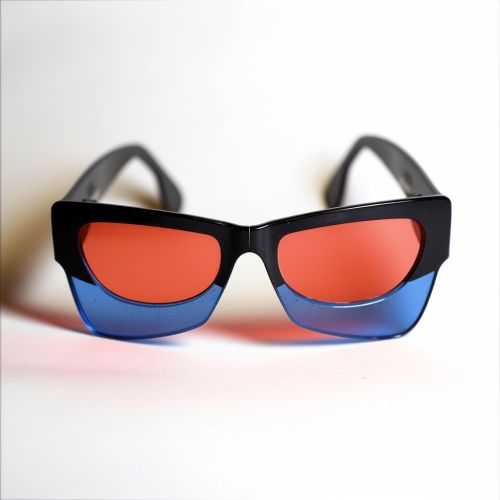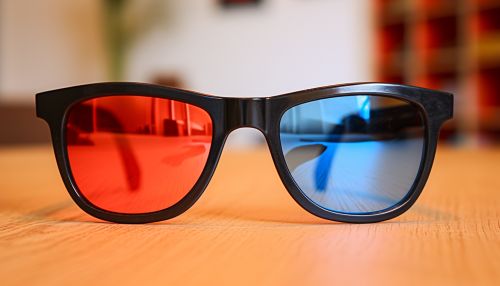3D film
History
3D film, also known as stereoscopic film, has a rich history that dates back to the early days of photography. The first patent for a 3D process was issued to William Friese-Greene in 1890. Friese-Greene was a British inventor and professional photographer who was a pioneer in the field of motion pictures. His patent involved the use of two images, each taken from a slightly different perspective, which when viewed together created a sense of depth and three-dimensionality.
In the 1920s, the first public 3D movie, "The Power of Love", was shown. The film utilized the anaglyph process, a method that uses two images, one in red and the other in blue or green, which are superimposed but offset with respect to each other to produce a depth effect. When viewed through anaglyph glasses, the viewer sees a single, three-dimensional image.


The 1950s saw a boom in 3D films, often referred to as the "golden era" of 3D cinema. This period was marked by the release of numerous 3D films, including "Bwana Devil", "House of Wax", and "Creature from the Black Lagoon". These films were often marketed with gimmicks, such as objects appearing to fly off the screen and into the audience.
However, by the late 1950s, the popularity of 3D films had waned. The process was often criticized for being gimmicky, and the required glasses were considered uncomfortable. In addition, the quality of the 3D effect varied greatly from film to film, and even from theater to theater, leading to a decline in audience interest.
Modern 3D Cinema
The resurgence of 3D films began in the 2000s, with the advent of digital cinema and computer-generated imagery (CGI). These technological advancements allowed for a higher quality 3D effect, and the use of lightweight, polarized glasses made the viewing experience more comfortable.
The 2009 film "Avatar", directed by James Cameron, was a landmark in the history of 3D cinema. The film was notable for its groundbreaking use of 3D technology and its success at the box office, which demonstrated the commercial viability of 3D films.
Modern 3D films are typically created using one of two methods: stereoscopic capture or 2D-to-3D conversion. Stereoscopic capture involves filming with two synchronized cameras, each capturing a slightly different perspective. This method is often considered to produce a higher quality 3D effect, but it is also more expensive and technically challenging.
2D-to-3D conversion, on the other hand, involves converting a 2D film into 3D in post-production. This method is less expensive and allows for greater control over the 3D effect, but it is also more time-consuming and can result in a less realistic 3D effect.
Technology
The technology behind 3D films involves creating an illusion of depth in a two-dimensional image. This is achieved by presenting two slightly different images to the left and right eye, respectively. The brain combines these two images into a single image with depth.
There are several methods for creating and displaying 3D images, including anaglyph, polarized, and active shutter. Anaglyph 3D, as mentioned earlier, uses two images, one in red and the other in blue or green. These images are superimposed but offset with respect to each other to produce a depth effect. The viewer wears glasses with red and blue or green lenses that filter the images, allowing each eye to see only one of the images, creating a 3D effect.
Polarized 3D uses two images that are polarized differently and projected onto the same screen. The viewer wears glasses with polarized lenses that allow each eye to see only one of the images, creating a 3D effect.
Active shutter 3D uses a series of rapidly alternating images and glasses with liquid crystal lenses that can darken and lighten in sync with the images. This allows each eye to see a different image, creating a 3D effect.
Impact and Criticism
3D films have had a significant impact on the film industry, both positively and negatively. On the positive side, 3D films often command higher ticket prices, which can lead to increased box office revenue. In addition, the immersive nature of 3D films can enhance the viewing experience, making the audience feel as though they are part of the action.
On the negative side, the increased cost of producing and exhibiting 3D films can be a barrier for some filmmakers and theaters. In addition, some viewers find the 3D effect to be distracting or even uncomfortable, leading to a preference for 2D versions of films.
Critics of 3D films often argue that the technology is used as a gimmick to increase ticket prices, rather than to enhance the storytelling. They also point out that not all films benefit from a 3D presentation, and that the technology should be used judiciously.
Future of 3D Cinema
The future of 3D cinema is uncertain. While some industry experts predict that 3D films will become the norm, others believe that the technology will remain a niche product, used primarily for certain types of films, such as action and animated films.
Advancements in technology may also influence the future of 3D cinema. For example, the development of glasses-free 3D displays could eliminate one of the main complaints about 3D films – the need to wear glasses. In addition, advancements in virtual reality and augmented reality could open up new possibilities for immersive, 3D storytelling.
